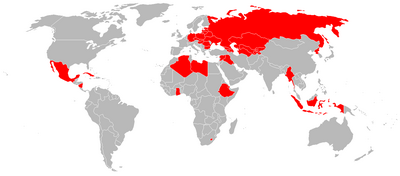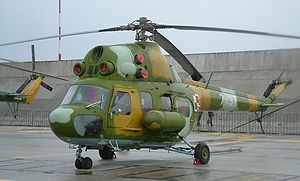| Mi-2 | |
|---|---|
| Polish Air Force Mi-2 at Krzesiny Air Base | |
| Role | Helicopter |
| Manufacturer | PZL-Świdnik, Poland[1][2] |
| First flight | September 1961 |
| Introduction | 1965 |
| Primary users | Soviet Air Force Polish Military Aeroflot |
| Produced | 1965-1998[3] |
| Number built | 5,497[3] |
| Developed from | Mil Mi-1 |
| Variants | PZL Kania |
The Mil Mi-2 (NATO reporting name Hoplite) is a small, lightly armored turbine-powered transport helicopter that could also provide close air support when armed with 57 mm rockets and a 23 mm cannon.
Design and development[]
The Mi-2 was produced exclusively in Poland, in the WSK "PZL-Świdnik" factory in Świdnik.
The first production helicopter in the Soviet Union was the Mil Mi-1, modelled along the lines of the S-51 and Bristol Sycamore and flown by Mikhail Mil's bureau in September 1948. During the 1950s it became evident, and confirmed by American and French development, that helicopters could be greatly improved with turbine engines. S. P. Isotov developed the GTD-350 engine and Mil used two of these in the far superior Mi-2.
The twin shaft-turbine engines used in the Mi-2 develop 40% more power than the Mi-1's piston engines, for barely half the engine weight, with the result that the payload was more than doubled. The Mi-2 fuselage was extensively altered from its predecessor, with the engines mounted overhead. However, the external dimensions remained similar.
After initial development at the Mil bureau (Soviet designation V-2) the project was transferred to Poland in 1964, after the first Świdnik-built example had flown (making this the only Soviet-designed helicopter to be built solely outside the Soviet Union). PZL-Świdnik produced a total of 5,497 units, about a third for military users. The factory also developed fiberglass rotor blades, and developed the wide-body Mi-2M seating 10 passengers instead of eight. Most typical kits include four stretchers for air ambulance usage, or aerospraying or cropdusting applications.
In Poland, there were also developed several specialized military variants for support or reconnaissance roles, with 23 mm autocannon, machine guns and/or two 57 mm rocket pods, four 9K11 Malyutka anti-tank missiles or Strela-2 AA missiles.
Operational history[]
The Mi-2 was first introduced into the Soviet Air Force in 1965. The Mi-2 is used by mainly former Soviet and Eastern Bloc countries, although it was also purchased by Mexico and Myanmar armed forces.
Most of the armed Mi-2 variants were used by Poland. Some were also used by the former East Germany (with machine gun and unguided rocket armament only).
North Korea still maintains a large active fleet of Mi-2s.
Variants[]

Mi-2 in Borki, Tver region, Russia

Mi-2Ch exhibited in Polish Aviation Museum

Mi-2 Plus - now retired air ambulance LPR in Poland

Mi-2P exhibited in Polish Army Museum in Warsaw. Helicopter in markings of the 42 eskadra lotnicza MSWiA based at Warszawa-Bemowo airfield.
- V-2
- First prototype.
- V-2V
- Armament prototype.
- Mi-2 Platan
- Aerial minelayer version.
- Mi-2A
- Mi-2B
- Upgraded export version for the Middle East, fitted with improved systems and navigational aids.
- Mi-2Ch Chekla
- Chemical reconnaissance / smokescreen layer version.
- Mi-2D Przetacznik
- Aerial command post equipped with R-111 radio.
- Mi-2FM
- Survey version.
- Mi-2P
- Passenger / cargo version, with accommodation for 6 passengers.
- Mi-2R
- Agricultural version.
- Mi-2RL
- Land rescue/ambulance version.
- Mi-2RM
- Sea rescue version equipped with electric winch for two people and dropped rafts.
- Mi-2Ro
- Reconnaissance version equipped with cameras.
- UMi-2Ro
- Reconnaissance trainer version.
- Mi-2RS Padalec ('Slowworm')
- Chemical and biohazard reconnaissance version.
- Mi-2S
- Air ambulance version, equipped to carry four litters, plus an attendant.
- Mi-2Sz
- Dual-control training version.
- Mi-2T
- Cargo/utility version.
- Mi-2U
- Dual-control training version.
- Mi-2US
- Armed version fitted with a fixed 23mm NS-23 cannon, 4 x 7,62mm PKT machine gun pods and optional cabin PK machine gun.
- Mi-2URN Żmija ('Viper')
- Armed reconnaissance variant armed with a fixed 23mm NS-23 gun and two 16x57mm S-5 unguided rocket pods Mars-2. Optional 7,62mm PK machine gun window-mounted.
- Mi-2URP Salamandra ('Salamander')
- Gunship and anti-tank variant, armed with 23mm NS-23 gun, optional window-mounted 7,62mm PK machine gun, and 4x AT-3 Sagger (9M14M Malutka) wire-guided missiles on external weapons racks and 4x additional missiles in the cargo compartment.
- Mi-2URP-G Gniewosz ('Smooth snake')
- Mi-2URP with additional 4x AA missiles Strzała-2 (Strela 2) in two Gad rocket launchers.
- Mi-2 Plus
- Upgraded Mi-2 with uprated GTD-350W2 engines, all-composite rotor blades, new avionics and other modifications.
- Mi-3
- Planned Mi-2 derivative that lacked suitable engines for the program to continue.
- Mi-2MSB2
- Modernized by the Ukrainian Air Force, slated to enter the serial modernization/production in late 2011.
Operators[]

Mi-2 operators

Ex-East German Air Force Mi-2 in Hubschrauber Museum, Bückeburg

Ex-Luftwaffe Mi-2 in Peenemünde museum, summer 2001

Peruvian Army Mi-2 on display at Las Palmas Airbase, 2006
- Hungarian Air Force [15]
- Hungarian Police[16][17]
- Indonesian Navy[18]
- Indonesian Police[19]
- Polish Air Force[4]
- Polish Army[4]
- Polish Border Guard[26]
- Polish Navy[4]
- United States Army[29]
- University of Iowa[30]
Specifications (Mi-2T)[]

Cockpit of Mi-2 exhibited in Aviation Museum, Košice, Slovakia
Data from Jane's All The World's Aircraft 1982–83[33]
General characteristics
- Crew: One
- Capacity: 8 passengers or 700 kg (1,543 lb) internal, 800 kg (1,764 lb) external cargo
- Length: 11.40 m (37 ft 4¾ in)
- Rotor diameter: 14.50 m (47 ft 6⅞ in)
- Height: 3.75 m (12 ft 3½ in)
- Disc area: 165.13 m² (1,777.44 ft²)
- Empty weight: 2,372 kg (5,218 lb)
- Loaded weight: 3,550 kg (7,826 lb)
- Max. takeoff weight: 3,700 kg (8,157 lb)
Performance
- Maximum speed: 200 km/h (108 knots, 124 mph)
- Range: 440 km (237 nmi, 273 mi)(max internatal fuel, no reserves)
- Service ceiling: 4,000 m (13,125 ft)
- Rate of climb: 4.5 m/s (885 ft/min)
- Disc loading: 22.41 kg/m² (4.59 lb/ft²)
See also[]
References[]
- ↑ Łukasz Męczykowski, Mi-2. Polski hoplita, "Histmag.org", 25 czerwca 2009.
- ↑ Благовестов А. – Каталог современного оружия ведущих стран-производителей
- ↑ 3.0 3.1 Ми-2, "avia.cybernet.name"
- ↑ 4.00 4.01 4.02 4.03 4.04 4.05 4.06 4.07 4.08 4.09 4.10 4.11 4.12 4.13 4.14 "World Air Forces 2013". Flightglobal Insight. http://www.flightglobal.com/airspace/media/reports_pdf/emptys/101015/world-air-forces-2013.pdf. Retrieved 15 February 2013.
- ↑ "Belarus Air force Equipment". globalsecurity.org. http://www.globalsecurity.org/military/world/belarus/af-equipment.htm. Retrieved 12 February-2013.
- ↑ "Bulgaria Air Force - Equipment". globalsecurity.org. http://www.globalsecurity.org/military/world/europe/bg-air-force-equipment.htm. Retrieved 12 February-2013.
- ↑ "Bulgarian (PZL-Swidnik) Mi-2". Demand media. http://www.airliners.net/photo/Bulgaria---Air/Mil-(PZL-Swidnik)-Mi-2/0978293/L/&sid=01fd747510cbfcda9d74648813e9153e. Retrieved 12 February-2013.
- ↑ "Cuba Air Force Aircraft Types". aeroflight.co.uk. http://www.aeroflight.co.uk/waf/americas/cuba/Cuba-af-Mi2.htm. Retrieved 12 February-2013.
- ↑ "Force Aerienne du Djibouti". smallairforces.com. http://smallairforces.blogspot.com/2011/02/force-aerienne-du-djibouti.html. Retrieved 12 February-2013.
- ↑ "Estonia Air Force - Equipment". globalsecurity.org. http://www.globalsecurity.org/military/world/europe/et-air-force-equipment.htm. Retrieved 12 February-2013.
- ↑ "Germany East Air Force". nationalcoldwarexhibition.org. http://www.nationalcoldwarexhibition.org/explore/cold-war-country-information.cfm?country=Germany%20East&topic=Air%20Force. Retrieved 12 February-2013.
- ↑ "East-Germany Mil Mi-2". Demand media. http://www.airliners.net/photo/East-Germany--/Mil-(PZL-Swidnik)-Mi-2.../1339217/M/. Retrieved 12 February-2013.
- ↑ "Mil Mi-2 datbase". helicopter-database.de. http://www.helicopter-database.de/mi2_search.php?type=99999®=&cn=&batch=99999&operator=348&category=99999&sortby=99999&acindex=__. Retrieved 12 February-2013.
- ↑ "Polizei Mil Mi-2 (PZL-Swidnik)". Demand media. http://www.airliners.net/photo/Polizei/Mil-(PZL-Swidnik)-Mi-2.../0237584/L/. Retrieved 12 February-2013.
- ↑ "Hungarian Air Force History". globalsecurity.org. http://www.globalsecurity.org/military/world/europe/hu-af-history.htm. Retrieved 12 February-2013.
- ↑ "Hungary Police Aviation". aeroflight.co.uk. http://www.aeroflight.co.uk/waf/hung/pol/hung-pol-home.htm. Retrieved 12 February-2013.
- ↑ "Hungary Police Mil Mi-2". Demand media. http://www.airliners.net/photo/Hungary---Police/Mil-(PZL-Swidnik)-Mi-2/1975901/L/&sid=e5e4f2eb7899ae70a7fc6c6f7105cedf. Retrieved 12 February-2013.
- ↑ TEMPO Edisi 19-25 Maret 2007 (pp. 36-37)
- ↑ ANGKASA No.07 Edisi April 2007 (p. 16)
- ↑ "Order of Battle - India". milaviapress.com. http://www.milaviapress.com/orbat/india/index.php. Retrieved 12 February-2013.
- ↑ "Latvia Air Force Mil-(PZL-Swidnik)-Mi-2". Demand media. http://www.airliners.net/photo/Latvia---Air/Mil-(PZL-Swidnik)-Mi-2/1850982/L/&sid=a01ac356f96350ddee0be863e908ad54. Retrieved 12 February-2013.
- ↑ "Lithuanian Air Force - Equipment". globalsecurity.org. http://www.globalsecurity.org/military//world/europe/lt-air-force-equipment.htm. Retrieved 12 February-2013.
- ↑ "Lithuania - Air Force Mil Mi-2". jetphotos.net. http://jetphotos.net/viewphoto.php?id=7373207. Retrieved 12 February-2013.
- ↑ "Mexican Armada". aeroflight.co.uk. http://www.aeroflight.co.uk/waf/americas/mexico/mex-naval-aircraft.htm. Retrieved 15 February-2013.
- ↑ World Air Forces - Historical Listings Mongolia (MON). worldairforces.com. Retrieved on 2013-08-27.
- ↑ "Poland Border Guard Aircraft Types". aeroflight.co.uk. http://www.aeroflight.co.uk/waf/poland/bg/types/pol-border-aircraft.htm. Retrieved 12 February-2013.
- ↑ 27.0 27.1 27.2 "Mi-2 Helicopter. History of Development". http://www.mi-helicopter.ru/eng/index.php?id=123. Retrieved 15 February 2013.
- ↑ "Ukraine - Air Force Equipment". globalsecurity.org. http://www.globalsecurity.org/military/world/ukraine/vps-equipment.htm. Retrieved 12 February-2013.
- ↑ "United States Army Threat Systems Management Office (TSMO)". angelfire.com. http://www.angelfire.com/dc/jinxx1/TSMO/TSMO.htm. Retrieved 12 February-2013.
- ↑ "Operator Performance Labs". opl.uiowa.edu. https://hfdata.opl.uiowa.edu/opl/?q=mi2. Retrieved 12 February-2013.
- ↑ "Mi-2 DataBase". helicopter-database.de. http://www.helicopter-database.de/mi2_search.php?PageSize=25. Retrieved 12 February-2013.
- ↑ "Aeroflot Mil Mi-2". jetphotos.net. http://jetphotos.net/viewphoto.php?id=268307. Retrieved 12 February-2013.
- ↑ Taylor 1982, pp. 169–170.
- Mondey, David, Encyclopedia of The World's Commercial and Private Aircraft. Crescent Books, New York NY, 1981. p. 245, "WSK-Swidnik Mi-2 Hoplite"
- Taylor, John W. R. Jane's All The World's Aircraft 1982–83. London: Jane's Yearbooks, 1982. ISBN 0 7106-0748-2.
- Mi-2 DataBase
- Mi-2 Photo Gallery
External links[]
| Wikimedia Commons has media related to Mil Mi-2. |
| |||||
The original article can be found at Mil Mi-2 and the edit history here.
